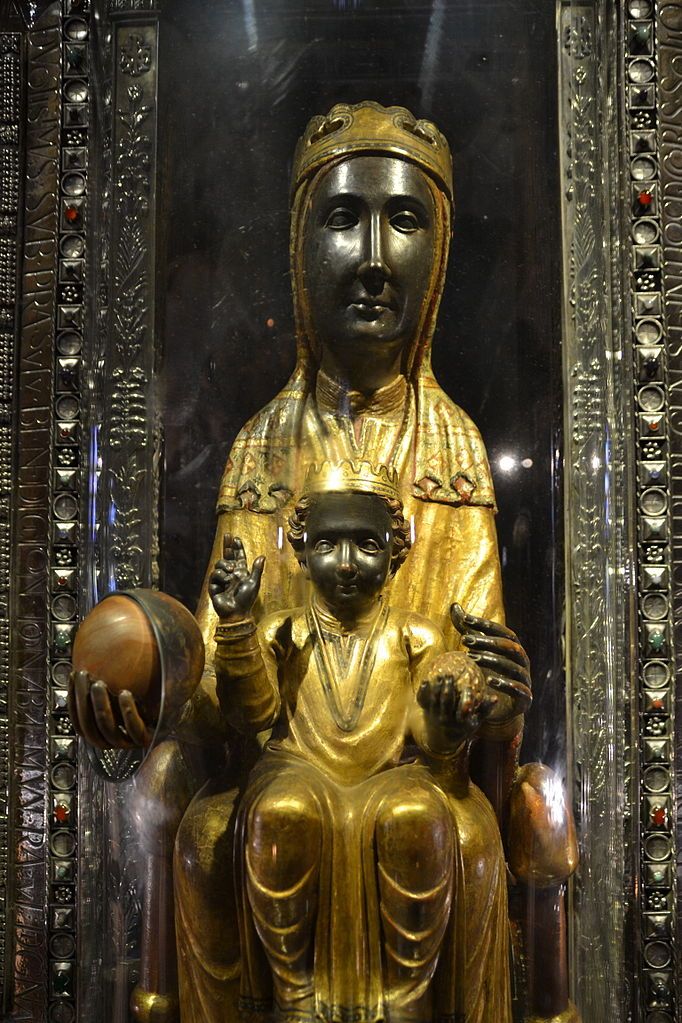The Image of the the Virgin Mary at Montserrat, Catalonia
Page Content
| Black Madonna of Montserrat |
Whether you are religious or not, visiting the Black Madonna at Montserrat is a spiritual and worthwhile experience. You will join in line with a group of people, many of whom have come as pilgrims to the statue – the atmosphere is electric. Chances are you will have to wait to see the Madonna. However, all of this can serve to enhance your visit – make the most of the opportunity to take in your surroundings. The stairway leading to the statue, plus the room and altar in which the statue sits are ornate, golden and pay tribute to the wonder that is the Virgin herself.
The Black Madonna is sometimes referred to by other names, including ‘The Virgin of Montserrat’ and ‘La Moreneta’. The statue sits behind a sheet of glass. However, one of her hands that is holding a sphere (which symbolises the universe) is not behind the glass. It is tradition for you to kiss or touch the Virgin’s hand whilst opening out your other hand to Jesus.
This page will provide you with details of the history of the statue of the Black Madonna, plus information on where it is, whether you have to pay to see it, the waiting times for seeing the Black Madonna and accessibility to the statue.
Book tickets for your half day tour to Montserrat from Barcelona with return journey
There are two organized tours that save you the time and trouble of organizing your own trip to Montserrat. They include return journey from Barcelona to Montserrat in an air conditioned bus. You can choose either a half day morning tour or half day afternoon tour.
Morning Tour
Click here to book your tickets online for the Montserrat Morning guided tour leaving from Barcelona
The history of the Black Madonna
The Black Madonna was believed to have been carved in Jerusalem at the beginning of the religion.
| Montserrat Basilica |
As you enter the doorway to the Basilica that will take you to the Black Madonna statue (see below for where this is), you will pass the chapels that lead to the Virgin. The first chapel is in honour of Saint Peter, the second is in honour of St Ignatius of Loyola, the third is on honour of St Martin, and the fourth is in honour of St Joseph Calasantius.
In 1944 it was decided that a new room, known as the ‘throne room’ would be built with a stairway leading to the statue.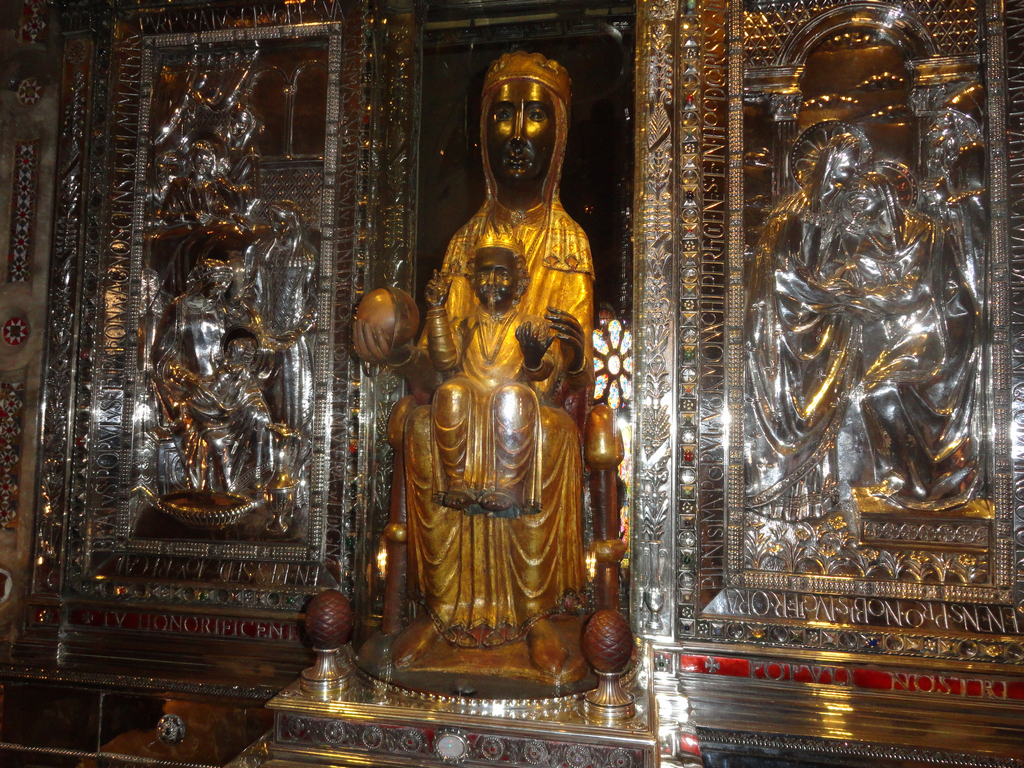
The new building work was scheduled to be completed on 27 April 1947 – a day to be known as the Enthronement. However, work finally finished in 1954.
As you enter the room where the Virgin sits, it is worth noting the doors – they are made of repousse silver and were created by Josep Obiols, Rafel Solanic and Manuel Capdevila. The Black Madonna herself sits on an incredibly ornate throne which is covered in Venetian mosaics. At either side of the Virgin, you will spot nine silver lamps – these represent the eight dioceses of Catalunya and Montserrat. Above the Virgin’s head, there are Angels that were created by the sculptor Marti Llaurado.
On leaving the altar of the Black Madonna, at the bottom of the stairs, you will be given the opportunity to say a prayer in the chapel of the Image of the Mother of God.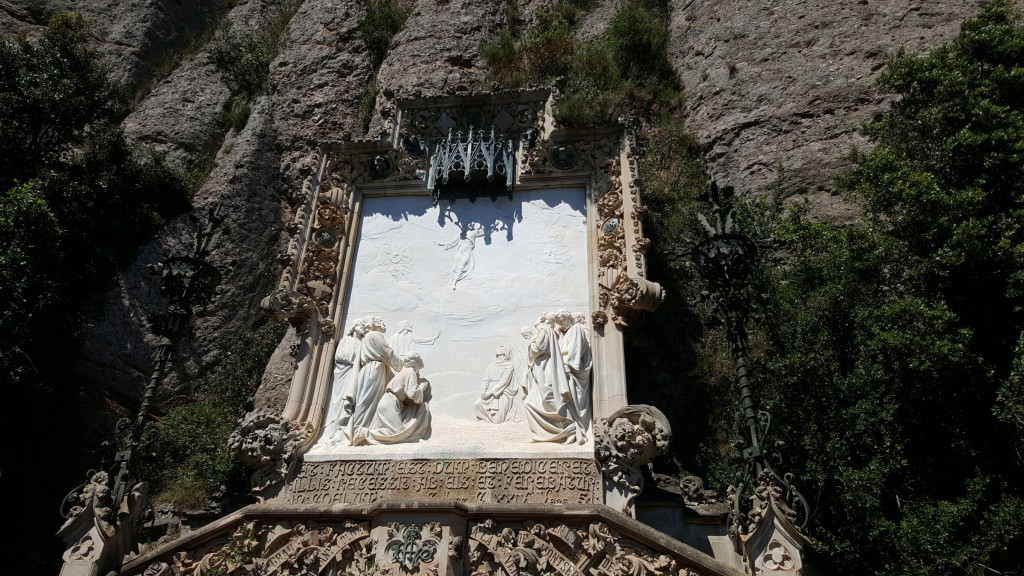
Why is the Madonna Black?
One of the most common questions about the Black Madonna is why she is black. The dark colour of the Virgin’s face is the reason why locals have nicknamed her ‘La Moreneta’ (“the little black lady”). Contrary to popular belief, she is not black due to a portrayal of a Black African Madonna. The blackness also does not come from a dark colour in the wood or from earlier coverings in the paint. It is known from historical descriptions of the Madonna that she has simply darkened over time.
The Ave Maria Path
The Ave Maria Path (Cami de l’Ave Maria) at Montserrat
On leaving the area where you have seen the Black Madonna you will exit via the Cami de l’Ave Maria. This area is a moving place where you will be given the opportunity to pay homage to the statue that you have just seen. Each candle that you will see has been lit as a prayer to the Virgin Mary.
| Stained glass window in the Basilica at Montserrat |
If you want to light your own candle for the Virgin, you will need to purchase one from the cages that sit in the atrium to the Basilica. They are sold on the basis of trust – simply choose the size of the candle that you would like to buy and put the correct change in the metal box provided (you will need to have the correct change unless you would simply like to make a donation).
Where is the Black Madonna?
The Black Madonna is located at the back of the Montserrat basilica, looking down over the altar. On entering the atrium of the Basilica you will see a doorway to the right. Enter this doorway where you will join the queue to see the Black Madonna.
Candles on the Ave Maria Path
Do I have to pay to see the Black Madonna?
There is no charge for visiting the Black Madonna.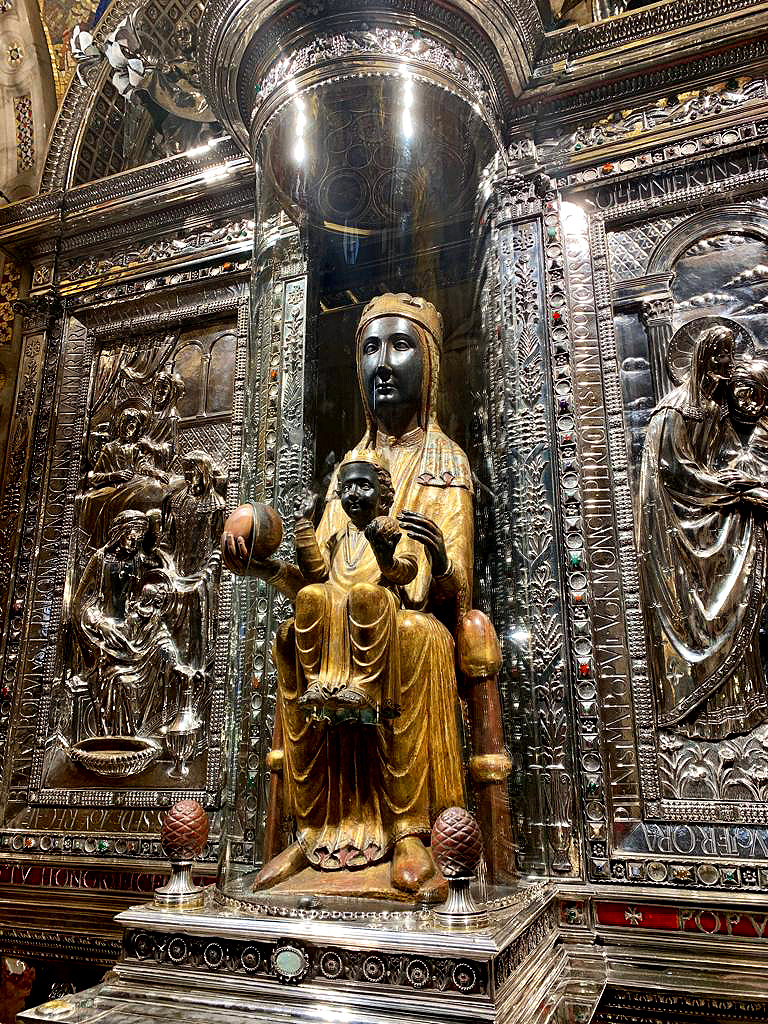
What are the waiting times?
Considering the fact that the Black Madonna is one of the most popular attractions at Montserrat and considering the small room that it is contained within, you are almost certainly going to have to queue to visit it. Waiting times will depend on the time of year that you visit, whether you visit during the week or at the weekend and what time of day that you visit.
At busy times you will wait from 20 – 45 minutes to see the Black Madonna.
To avoid long queues for visiting the Black Madonna, it is best to visit in the afternoon. This is due to the fact that most coach visits to Montserrat take place in the morning and so the whole Monastery is a lot busier during these hours. It is also worth remembering that the famous boy’s choir sing every day, for this reason, the queues for the Black Madonna are far shorter during this time.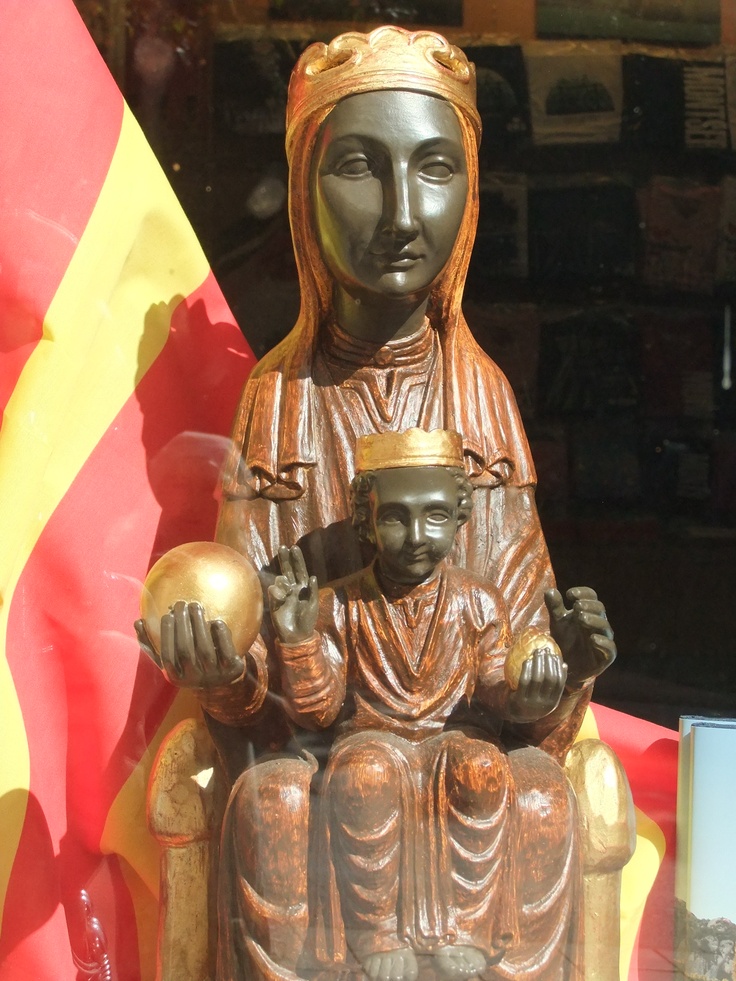
The Boy’s Choir Performance Time: 13:00
Limited mobility accessibility
Unfortunately, the Black Madonna statue is the hardest place to reach if you have limited mobility in the whole of the Montserrat Monastery. There are very narrow stairs leading to the statue and the historical nature of the building means that there is no stair lift or elevator.
However, it will be possible to view the Black Madonna sculpture from the bottom of the stairs at a distance of two metres. To do this, you will need to access the Black Madonna from the Cami de l’Ave Maria (see above for more details). At the end of this walkway, there are stairs leading to the exit of the Black Madonna area. There is a stairlift to get up these stairs. Once you are at the top of these stairs, you can enter a small chapel where you will be able to view the Black Madonna from the bottom of the stairs.
Whether you plan on visiting Montserrat for the history, the spirituality or its natural surroundings, it is worth paying a visit to the Black Madonna.
All About Our Lady Of Montserrat (Barcelona, Spain)
EVERYTHING ABOUT THE MONTSERRAT VIRGIN
Montserrat, from “Mont” (mount) and “serrat” (serrated). The name applies to a rocky mountain located less than 1 hour drive from Barcelona (Spain), whose shape made locals think it had been the angels that serrated the mountain with golden saws. And it also applies to the Black Madonna found in the mountain by miracle in the 800’s.
Her story and influence has always fascinated me, and I never get tired of taking people on a tour to admire Her. Her serene face brings me inner peace, and it also reminds me of my late grandparents, who were very devoted and came to the monastery in their honey moon back in the mid 1900’s, when it was a trip, not just a quick ride. Today I want to share with you my view about the famous Black Madonna of Montserrat and everything you need to know about her.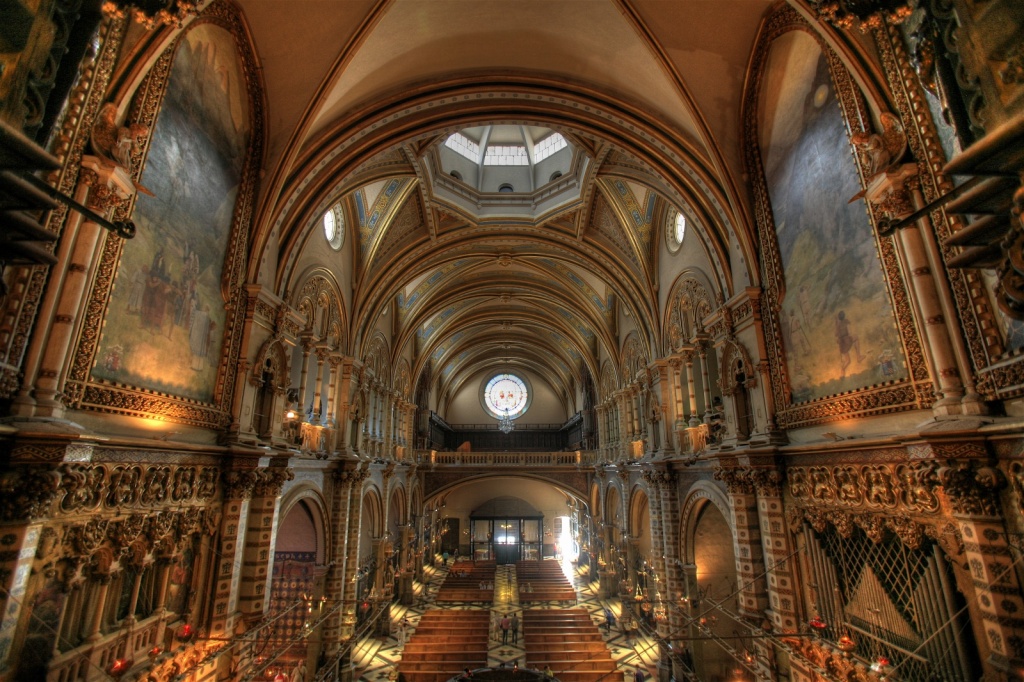
Our Lady of Montserrat Miracles & History
Origins that get lost in the mist of time
The fascinating shapes of the Montserrat Mountain have inspired spirituality for centuries. Some sources indicate that in the Roman times (197DC, according to some), there was already a Roman temple dedicated to Venus, Goddess of beauty, love and fertility.
And the Virgin Mary is historically seen as a (purer) equivalent of such deity. Interestingly enough, the temple would have been located where now stands the Chapel of Saint Michael, less than 30 minutes walk from the monastery, and not many feet above the location of the Holy Cave, where Our Lady of Montserrat was found.
As for the statue, some believe Jesus himself asked Saint Luc to carve a sculpture with the portrait of the Virgin Mary, and that she lent him the carpentry tools she still kept at home. Years later, Saint Paul arrived to Barcelona on a boat, carrying that sculpture with him, which he gifted to the local Christian community.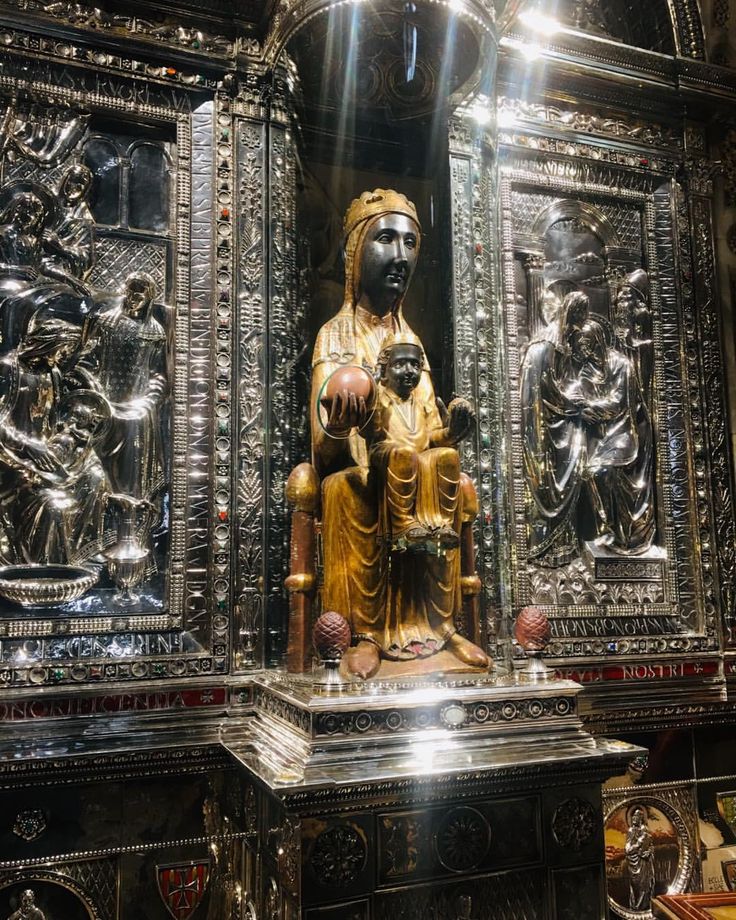
In 718 Barcelona was attacked by the moors, and the Christians decided to evacuate the sculpture and hide it in a cave in the mountain of Montserrat. But since the moors controlled Barcelona for the next 80 years, the exact location of the image was eventually forgotten.
The legend of how she was found by miracle
While the stories about the temple of Venus and the Jerusalemite origins of the Black Madonna at Montserrat aren’t widely known by locals, any Catalan that you ask will be able to tell you how She was found by miracle.
PRIVATE MONTSERRAT HALF DAY TOUR
The story goes that one night, in 880, a group of young shepherds saw light coming out of a cave in the mountain. There was also music playing. When they approached it, they saw a sculpture of the Virgin Mary surrounded by angels playing instruments and signing.
They decided to run to the Bishop, the highest authority – sources don’t agree if it was the Bishop of Manresa or the one of Barcelona – but Manresa is much closer.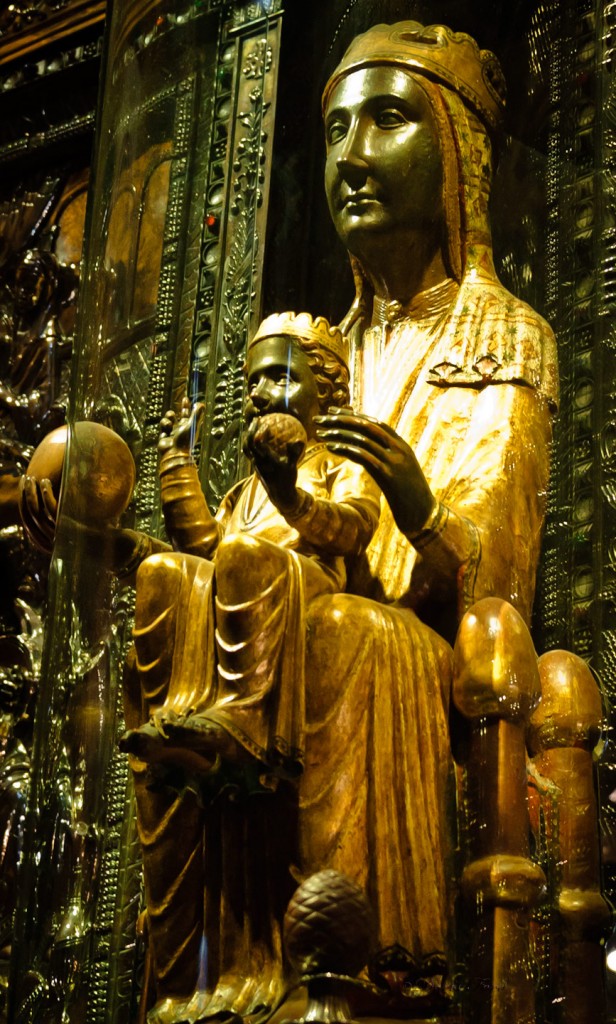
Anyway the Bishop went to the cave with them and decided to take the sculpture to town so she could be properly worshipped in the Cathedral. But as they started carrying her down another miracle happened: she started becoming heavier and heavier, so in the end nobody was able to lift her up anymore. That’s when the Bishop understood the message: She wanted to stay in the mountain.
Brief history of the Montserrat Monastery
While the first documented chapel to the Virgin of Montserrat dates back from 888, it wouldn’t be until 1025 that the Abbot Oliva, one of the most powerful characters of the Catalan Middle Ages, ordered to create a monastery for her.
TAKE OUR MONTSERRAT AND SITGES TOUR
By the 1100’s it had won the range of Abbey, and pilgrims started arriving attracted by the stories about the miracles that led to Her discovery.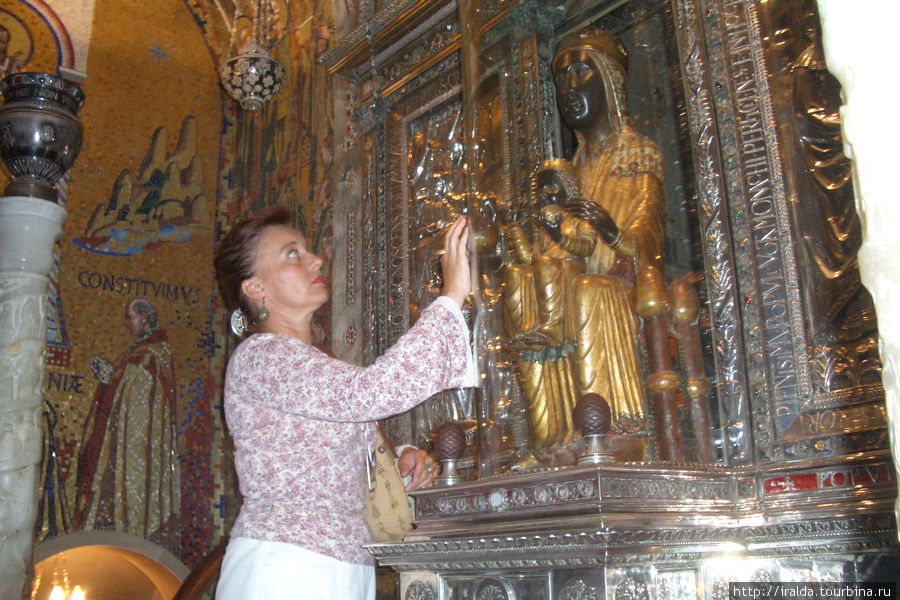
The end of the 1400’s brings the construction of the Gothic cloister and the arrival of one of the first printers in Spain. Bernat Boïl, one of the hermits, joins Christopher Columbus in this second trip and names one of the Caribbean Isles where they stop after the Madonna of Montserrat.
Unfortunately, during the Napoleonic Wars (1811-12) the monastery was attacked and seriously damaged. As a result, most of the buildings visited nowadays belong to the reconstruction from the early 1800’s.
The Image of the Montserrat Black Madonna
The statue of Our Lady
The image of the Black Madonna in Montserrat is, alas, not the one from the old legends. It is instead a Romanesque carving from the 11 or 1200’s. It is unknown when it came to replace the original one or what happened to it.
MONTSERRAT & COLONIA GUELL TOUR
Following the Romanesque tradition, the Mother of Jesus is presented in a static way with the Child on her lap – more a throne for the Savior than a loving mother.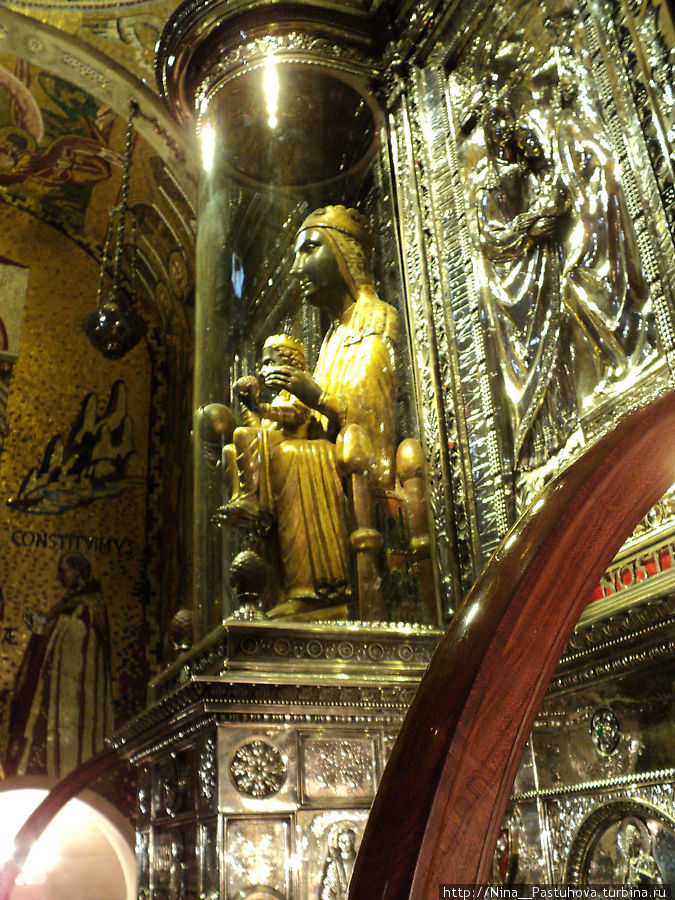
She holds a sphere on her right hand, which has been interpreted as the universe – a symbol of power. The child holds instead a pine cone – symbol of eternal life (pine trees are evergreen).
“La Moreneta”, or why is She a Black Madonna?
The Virgin of Montserrat is a Black Madonna: her skin is dark. That shouldn’t be seen as an African or Iberian influence, though: old records show her skin light (and you can see that in the section of the Museum of Montserrat dedicated to Her).
MONTSERRAT AND WINE TOUR FROM BARCELONA
What recent restoration works suggest is that at first the smoke of the candles surrounding the image started sooting it. And maybe the paint and varnish covering it rusted, too, darkening its surface. Until around the 1500’s it was painted in a light brown color, probably thinking they were returning it to its original color.
Another layer of paint dating from the 1800’s was added in a dark brown color. By then the locals had already given her the sweet nickname of “La Moreneta”, the little sun-tanned girl. For them it would have been a shock to have been cleaned back to a whiter color. And that’s how she got to our times being a Black Virgin, and she’ll continue to be.
Venerating the Black Virgin of Montserrat
The Montserrat Virgin for Spain and Catalonia
The Black Madonnna of Montserrat is one of the 51 Black Virgins in Spain, and hierarchically probably the second most important. The Virgen del Pilar from Zaragoza and the Virgen de Guadalupe from Extremadura are also Black Madonnas, and they rival for the title of female patron saints of Spain.
The Montserrat Black Madonna is however, the patron saint of Catalonia – declared so by Pope Leo XIII in 1881. Catalan celebrate her day on April 27th. Montserrat is a very common given name for ladies, and they are often called Montse, Muntse or Mon for short.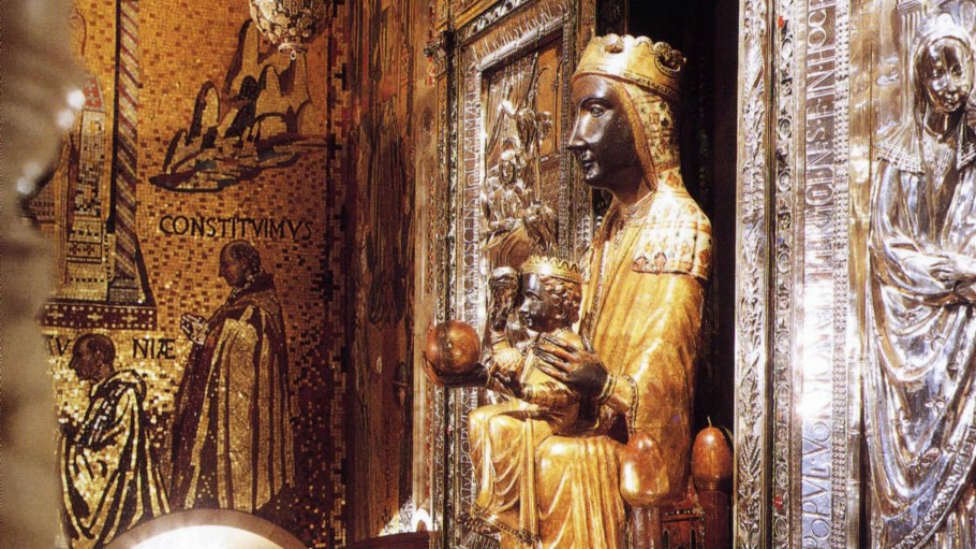
Our Lady of Montserrat statue Virgin Mary print…
My Journey to the Black Madonna: A Memoir
Black Madonna
The Virolai Anthem
The Virolai is the anthem of Our Lady of Montserrat. Many Catalans call the song “Rosa d’Abril” (April Rose), because that’s the start of its first line. The words were written by the poet and priest Jacint Verdaguer and sang for the first time in 1880 during the celebration of the 1000 anniversary of the monastery of Montserrat.
The music was composed by Josep Rodoreda. You can hear the Escolania Choir perform it every day at 1PM in the Royal Basilica of Montserrat (except Sunday, when it’s sung at noon right after mass is over).
Historical characters that prayed to the Montserrat Black Madonna
The most famous Saint to have worshipped the Black Virgin of Montserrat is Saint Ignatius of Loyola.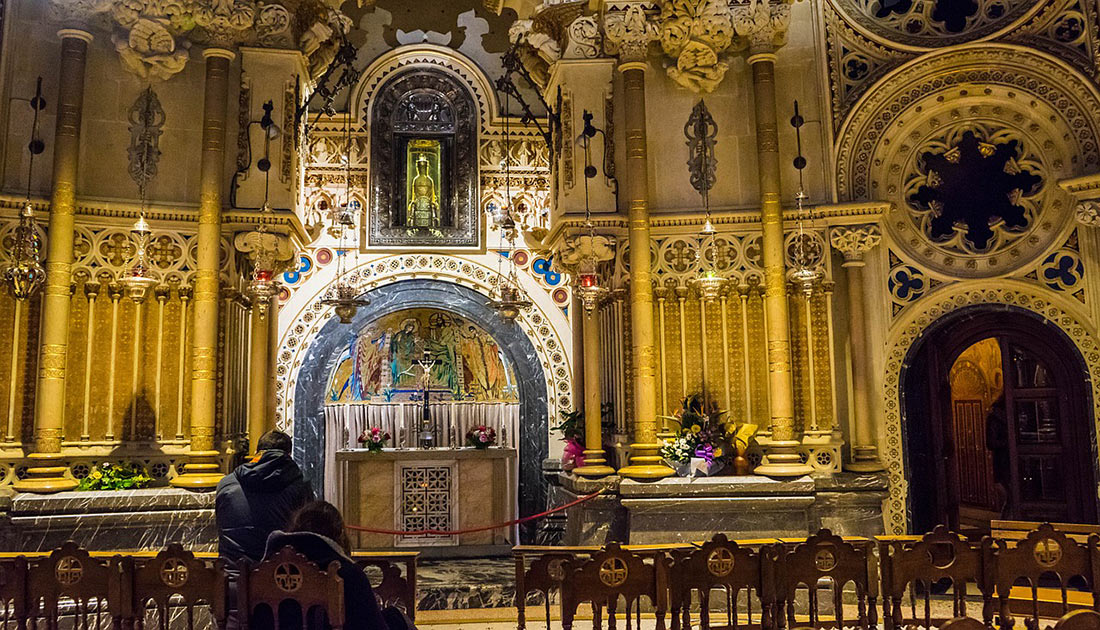
Other minor local Saints such as Saint Peter Nolasco, Saint Vincent Ferrer, St. Joseph Calasanctius and Saint Antony Mary Claret. Also St. Francis Borgia, nephew of the famous Lucrezia Borgia and grandson of Pope Alexander VI (Rodrigo Borgia). And more recently, Pope John XXIII visited when he was still a cardinal, and Jean Paul II visited in 1982.
European royals were also devoted to Her. Both Emperor Charles V and King Philip II of Spain died holding blessed candles from the Montserrat Monastery. King Louis XIV of France paid the Montserrat monks so they’d pray for his mother. And also the Emperor Ferdinand III of Austria made generous donations, too.
Visiting the Black Madonna at Montserrat
The Holy Cave
Santa Cova (Holy Cave) is the name of the Chapel located by the mountain cavity where the legend says Our Lady of Montserrat was found.
MONTSERRAT & BARCELONA TOUR
A paved path that often involves steps takes you there from the Monastery in some 45 minutes walk. You can, though spare 10 minutes walk or so by taking the Funicular de la Santa Cova. It doesn’t sound like a big saving, but it’s the steepest part and it’s a great idea for the way back, when it’s uphill.
The path is adorned with sculptures of the Sorrowful Mysteries of the Passion of Jesus. A young Antoni Gaudí participated in the creation of the first mystery of the Glory. While it’s hard to track his imprint, a Catalan flag made of broken mosaic tile pieces gives you a hint.
The Chapel of the Holy Cave is only open until the late afternoon and the access is free of charge. Inside you can appreciate that the wall behind the altar is not man-made, but the actual rock of the mountain. It sort of looks like a a small rock shelter, but it might be disappointing to see that’s not really an actual “cave”.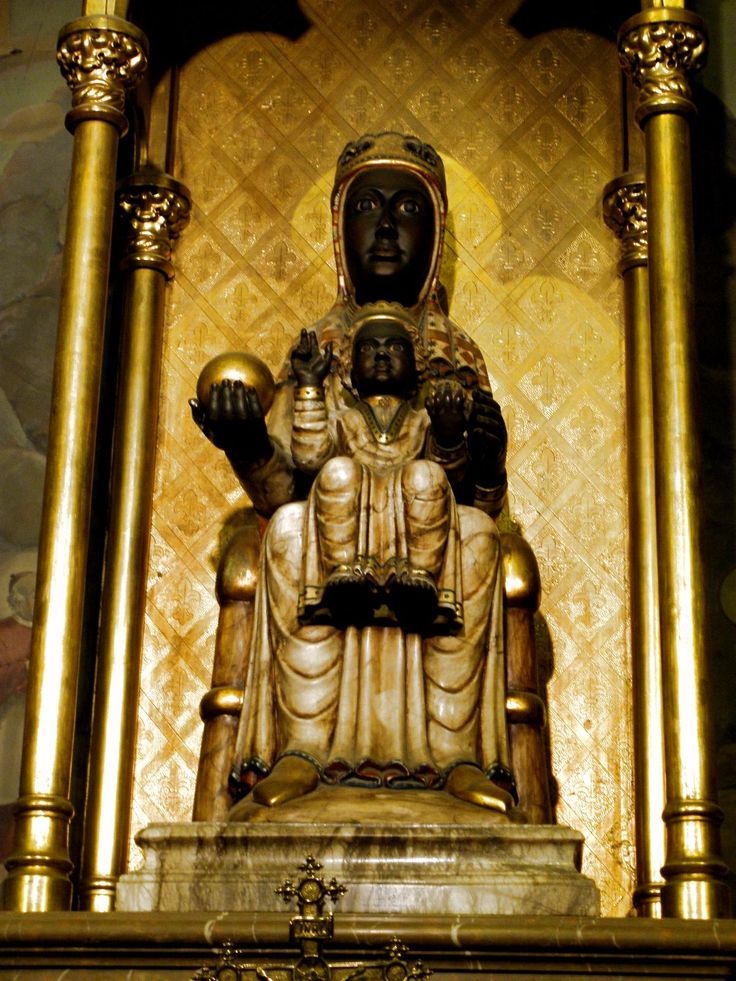
Her Shrine in the Basilica
The Black Madonna of Montserrat is worshipped in a small shrine overlooking the altar of the Basilica from high above. Since the Covid pandemic it needs to be booked in advance. It’s free for individuals but paid for tourist groups.
PRIVATE MONTSERRAT AND GIRONA TOUR
A path connecting the side chapels of the right aisle of the Basilica leads to a staircase decorated with a golden mosaic representing Virgin and Mother Christian saints. Then after going through a small hall displaying some religious artifacts you go up some more steps before crossing the silver doors of the Black Madonna shrine (known as “cambril”).
The tradition is touching or kissing the sphere on the hand of the Montserrat Virgin and making a wish. You can also say a short prayer and take a quick picture of the Basilica and its rose window from the balcony, before letting the next people in line take your spot.
As you exit, you’ll see a small circular chapel surrounded by stained glass windows. It is often used for weddings and to offer you the opportunity of longer prayers. From there, above the altar, you see the Black Madonna from behind.
The exit is done via the Camí de l’Ave Maria, a path between the Basilica wall and the mountain rocks, decorated with ceramic plates and the words of the Virgin Mary Litany. There’s also candles lit by the pilgrims for Her.
How to get to Montserrat from Barcelona
WALKING. There’s a hiking trail connecting Barcelona with Montserrat, the GR-6. It’s about 57km / 35.5 miles, and it takes around 15 hours to complete it. This hike is part of the Camino de Santiago and the Saint Ignatius route.
DAY TRIP FROM BARCELONA TO MONTSERRAT
- BY CAR. There’s two main roads taking you to Montserrat and both take about the same amount of time (about 1 hour). There’s the C-58 that goes through the Valles county, then joins the C-55 to Monistrol de Montserrat at the foot of the mountain, then on to the Monastery.
Then there’s the A2 that follows the Llobregat river. Upon reaching Abrera you can take the local road BV1201 to reach the monastery from the Monistrol side, or continue along the mountain to El Bruch, and take the B111.
- BY TRAIN. The R5 is a suburban line that departs from Plaça Espanya and has two stops in Montserrat. The first one is the Aeri de Montserrat, where you switch to a cable car that takes you to the monastery. The next one is Monistrol de Montserrat, where you switch to the rack train going up the mountain to the monastery, too. If you are planning to take the train, consider purchasing this pass – it’s a very good deal!
- BY BUS. There’s only one public bus heading to Montserrat every morning at 9.15 from the Bus Station of Sants Estacio. Then it heads back to Barcelona in the late afternoon (5PM or 6PM, depending on the season).
- BY TAXI. It’s a strange option to go to Montserrat from Barcelona by taxi, but you’ll make the driver’s day because he’ll make good money.
But it can be an option to go back if you miss the last bus or train. By the Information Point of Montserrat you’ll find a list of taxi phone numbers that can come pick you up at the monastery and take you back to the city.
- GROUP BUS TOUR. There’s also several companies that organize big bus tours and small group tours to Montserrat. In most of them there’s a tour guide that gives explanations during the rides and gives you a quick tour before giving you free time until it’s time to get back. So you are mostly on your own.
- PRIVATE TOUR. This is a tour where you have your own tour guide with you at all times. You get explanations on the way there, you get the highlights tour, but then there’s also some time to do other things of your interest. And your guide will be with you to give you more explanations and help with logistics: which way to go, how long it’ll take, getting tickets in advance, and so on. You get your own personal experience that you don’t share with strangers.
Camino Ignaciano: Walking the Ignatian Way in…
(4)
Camino Catalan. The Tranquil Route towards…
Montserrat. Official Guide
Private Tours from Barcelona to Montserrat
At ForeverBarcelona we provide a variety of private tours to Montserrat, some of them combining Montserrat with one more destination. Let me share them with you, for your inspiration:
- Montserrat Half Day Tour. 5 or 6 hours. We take you to the Montserrat Monastery and you get to see the Montserrat Black Virgin Mary and everything else you want.
- Day trip from Barcelona to Montserrat. 8 hours. Like the half day tour, but we stay for lunch in a countryside restaurant at the foot of the mountain.
- Montserrat and Sitges tour.
8 hours. Morning in Montserrat and lunch by the sea in the town of Sitges.
- Montserrat and wine tour from Barcelona. Early visit of Montserrat, wine cellar visit and lunch in the wine country.
- Montserrat & Colonia Guell tour. 8 hours. Stop in Colonia Guell to see the other unfinished church by Gaudi, then continue to Montserrat for a visit and lunch in a countryside restaurant.
- Montserrat & Barcelona tour. 9 hours. Morning in Montserrat, then head back to Barcelona for a tapas lunch and a city tour.
- Montserrat and Girona tour. 10 hours. Morning in Montserrat and afternoon in Girona. And ambitious and long day for those who want it all.
Girona and Montserrat tour from Barcelona
Barcelona And Montserrat Tour
Private Montserrat Tour From Barcelona
Montserrat Colonia Guell Tour
Montserrat And Sitges Tour
Montserrat Winery Tour
Are you devoted to the Black Madonna of Montserrat?
Facebook Icon
Linkedin Icon
Youtube Icon
Pinterest Icon
Instagram Icon
AUTHOR BIO
Marta is the founder of ForeverBarcelona.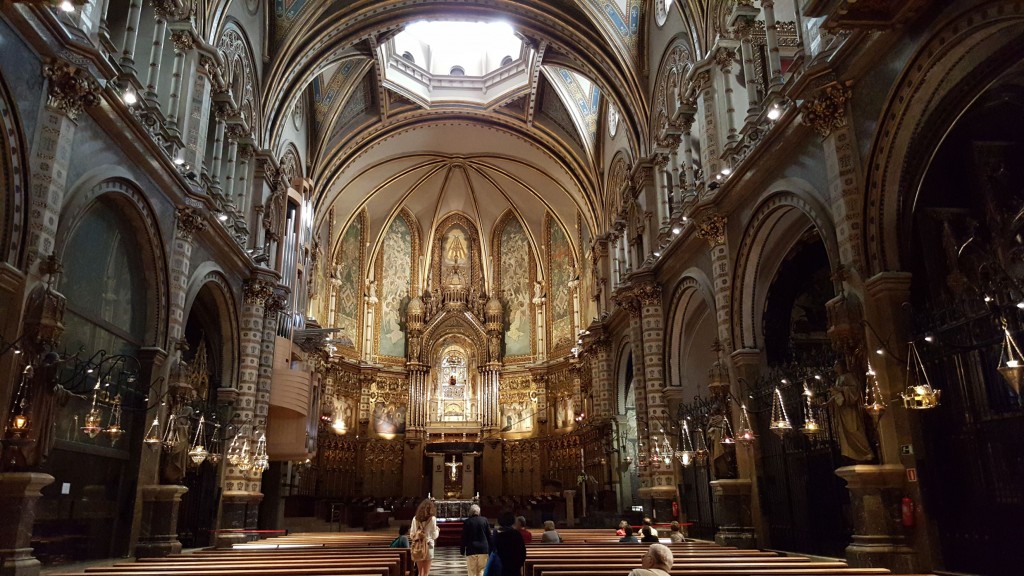
RESEARCHING FOR A TRIP IS TIME-CONSUMING…
Need more inspiration?
Our 100% FREE Barcelona Collection will give you everything you need to organize the trip of your lifetime to Barcelona.
BEST INSIDER TIPS FROM THE PROS!
MORE BARCELONA TIPS FOR YOU:
SHARE WITH YOUR TRAVEL MATES
Last update on 2023-04-24 / Affiliate links / Images from Amazon Product Advertising API
Statue of the Virgin Mary at Montserrat, Catalonia
Page Content
| Black Madonna at Montserrat |
For both religious and non-religious people, visiting the Black Madonna at Montserrat will be a spiritual and rewarding experience. Before you see the statue, you will need to stand in line, among the waiting ones in which there will be many pilgrims – the atmosphere there is very exciting.
The Black Madonna is sometimes also called the “Virgin of Montserrat” and “La Moreneta” (“Darkie”). The statue is behind glass. However, one of her hands, in which she holds a sphere (symbolizing the universe), is not covered with glass. Traditionally, you should kiss or touch the hand of the Virgin, stretching out your other hand to Jesus.
This page contains a description of the history of the Black Madonna statue, plus information about its location, whether you need to pay to visit it, how long you need to queue to see the Black Madonna, and the availability of the statue.
Book your tickets for a half day excursion to Montserrat from Barcelona with round trip
There are two organized tours that will save you time and hassle of organizing your own trip to Montserrat.
Morning excursion to Montserrat
Click here to purchase tickets online for the morning excursion to Montserrat from Barcelona
History of the Black Madonna
It is believed that the Black Madonna was created in Jerusalem in the early days of Christianity. This is a wooden statue. This is one of the most famous statues of the Black Madonna in the world, and in 1844 Pope Leo XIII declared the Virgin of Montserrat the patron saint of Catalonia. Black Madonnas are found all over the world, if you are interested in the history of the Black Madonna phenomenon itself and various variations of its image, then you should visit the Montserrat Museum, where there is a whole department dedicated to the artistic aspect of the creation of the statue and its history.
| Montserrat Basilica |
Immediately after entering the Basilica, where the statue of the Black Madonna is located (see below), you will see the chapels that lead to the Mother of God.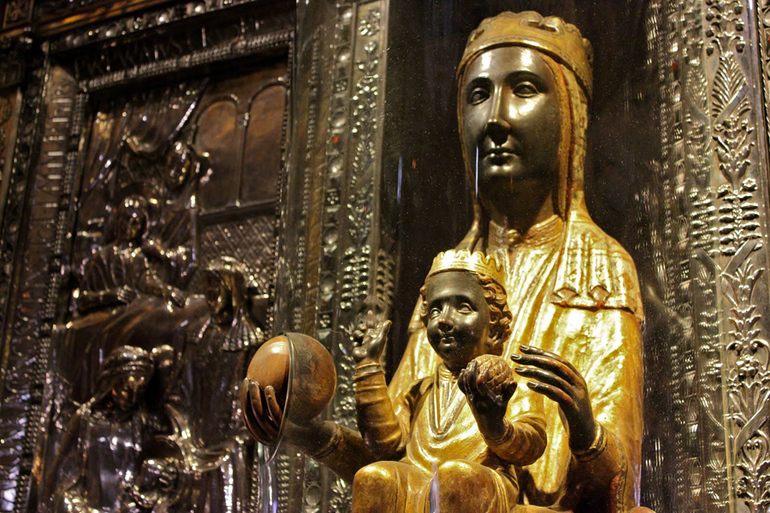
In 1944, a decision was made to build a new hall, called the “throne hall”, in which a staircase was installed leading to the statue. Sculptors, architects, artists and jewelers worked on the creation of the hall and the altar, which now houses the statue, under the guidance of the architect Francesc Folguera and the artist Josep Obiols.
Construction work was to be completed on April 27, 1947 – the day of enthronement. However, the work was completed only in 1954.
Once in the hall where the Mother of God is located, pay attention to the doors – they are made of embossed silver, and they were created by Josep Obiols, Rafel Solanic and Manuel Capdevilla. The Black Madonna herself is set on an incredibly beautiful throne covered with Venetian mosaics. Around the Virgin there are nine silver lamps – they represent the eight dioceses of Catalonia and Montserrat.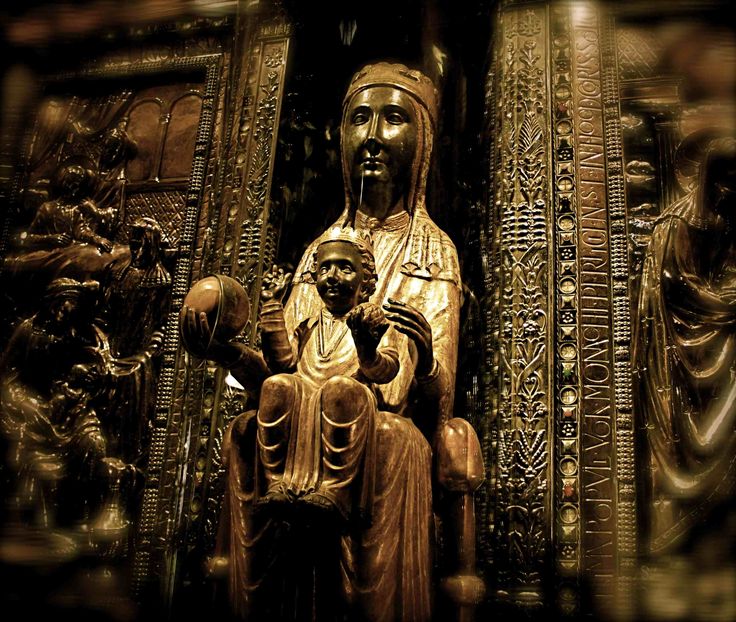
On the way back from the altar of the Black Madonna, at the end of the stairs, you will have the opportunity to pray in the chapel of the Image of the Virgin. The chapel was built in 1885 under the direction of Francisco de Paula del Villar y Lozano, who had a young Antoni Gaudí as his assistant.
Why is the Madonna black?
One of the most frequently asked questions about the Black Madonna is why is she black? Due to the dark complexion, the locals nicknamed the statue of the Virgin “La Moreneta” (“Darkie”). Despite popular belief, the statue is not black because it depicts an African Madonna. The color of the wood or the paint once used is also not the cause of the black color. According to historical evidence, the statue has darkened simply due to time.
Ave Maria Path
Ave Maria Path (Cami de l’Ave Maria) in Montserrat
After leaving the hall with the statue of the Black Madonna, you will find yourself on the Cami de l’Ave Maria.
| Stained glass window in the Basilica of Montserrat |
If you want to light a candle to the Mother of God, you can buy a candle in the courtyard of the basilica. They are sold on trust – just choose a candle of the size you need and put the appropriate amount of coins in the iron box (you need to have the exact amount in change, or it will be considered as a donation).
Where is the Black Madonna?
The Black Madonna is located in the far part of the basilica of the Montserrat monastery, above the altar. Once in the courtyard of the basilica, on the right you will see the doors. Enter them, there will be a queue to visit the Black Madonna.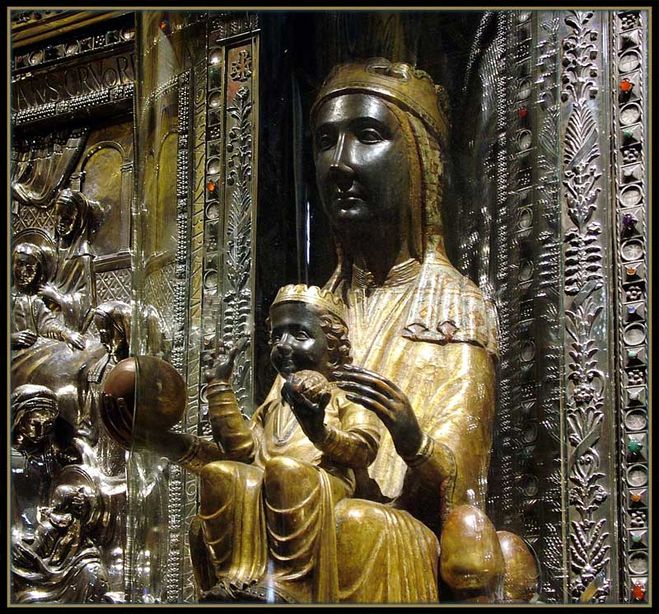
Candles on the Way Ave Maria
Do I need to pay to see the Black Madonna?
You can see the Black Madonna for free. However, there are donation boxes at the beginning and end of the stairs leading to the Black Madonna. If you want to make a donation for the needs of the monastery, then stock up on change in advance.
How long will you have to stand in line?
With the Black Madonna being Montserrat’s most popular attraction and the fact that the statue is in a small hall, there is no way to avoid queues. How long you wait in line depends on the season, day of the week, and time of day.
During peak hours you will have to wait between 20 – 45 minutes to see the Black Madonna.
In order not to stand in long lines to the Black Madonna, it is recommended to arrive in the afternoon. This is due to the fact that most buses with tourists arrive in the morning, so there are many more people in the entire Montserrat monastery at this time.
Accessibility for people with disabilities
Unfortunately, the hall with the Black Madonna is the most inaccessible place for people with disabilities in the entire monastery of Montserrat. A narrow staircase leads to the statue, plus the old building does not provide for elevators.
However, the statue of the Black Madonna can be viewed from below, without climbing the stairs, from a distance of two meters. To do this, you will need to approach the Black Madonna from the side of the Cami de l’Ave Maria path (see above). At the end of this path there is a staircase – the exit from the Black Madonna. There is a special lift chair on this staircase. Climbing these stairs, you will find yourself in a small chapel, from where you can see the Black Madonna, located at the top.
The Black Madonna is worth a visit in any case, even if you come simply because you are interested in history or spiritual experience, or just the surrounding nature.
Montserrat – the legend of the Black Madonna
Montserrat – the legend of the Black Madonna
In this article we will talk about the most important legend associated with the monastery and the sacred mountain of Montserrat – of course, speech
about how exactly the statue of the Black Madonna of Montserrat, or “Morenets” was acquired, as the Catalans themselves used to call the image of the Montserrat Virgin.
Let’s leave aside the results of scientific research conducted on the statue of the Virgin Mary of Montserrat repeatedly and turn to the legends. To be precise – to a written source
1239, in which the legend of the discovery of the miraculous statue of the Black Madonna of Montserrat is first found.
Fast forward to the distant year 880 from the birth of Christ. Legend has it that this very year the shepherd boys from Olesa (a town near Mount Montserrat – however, at that time he was clearly
village) witnessed an extraordinary phenomenon one Saturday.
also had musical accompaniment.
In any case, it seemed to the shepherds that a whole choir of angels was playing a soulful melody all the time that light came from the mountain. After the light went out, the singing stopped, and the shepherdesses, sighing,
drove the sheep home.
However, the impressions of what they saw and heard were so strong that, unable to bear it, they told their parents about everything. I’m not sure that the parents reacted to the stories of their children with complete
trust.
Perhaps one of the children even got a belt from a strict father, who was amazed at how smoothly, inspiredly and stubbornly his offspring was lying. The children, meanwhile, as if by agreement, repeated
one thing: there was light, and there was music, and they had never seen anything more beautiful in their short life.
The next Saturday, at exactly the same time, the phenomenon repeated itself: light, music, an angelic choir – and the boys, returning home, again informed their parents about what a wonderful sight
have just seen.
Another Saturday came, and the parents, in order to check whether their children were telling the truth, went to “watch the lights” with them, promising that if nothing happened, the children would be put in a belt, and
then the rod, so that the desire to compose fables will disappear from them for a long time – if not forever.
Listening to these threats of harsh Catalan parents, the children trembled inwardly: well, how can nothing happen this time? Nobody canceled the law of meanness! It won’t seem enough to them then,
exactly! However, the fears of the shepherds were in vain. The light shone, the music rang like God’s bells, and the voices of the angels seemed to take you straight to heaven.
Discouraged, touched and shocked, the fathers and children returned home – and the most incredible rumors spread around Olesya.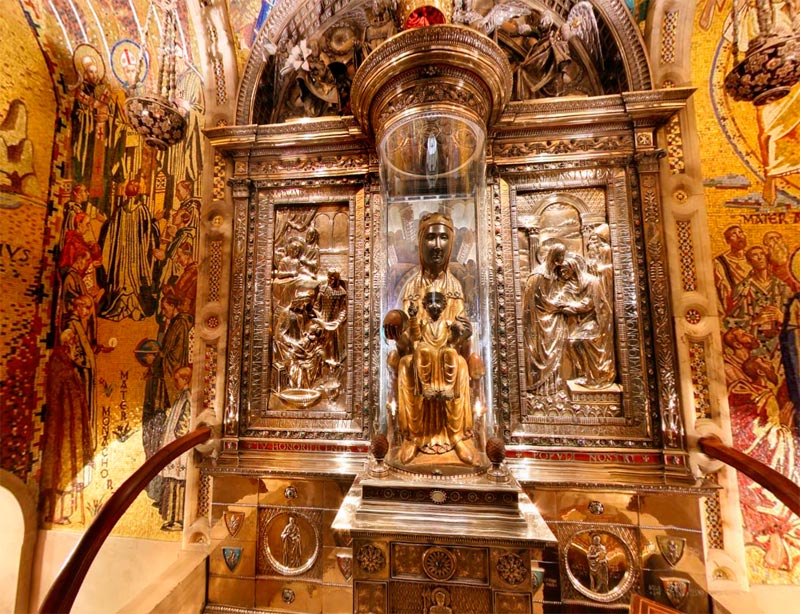
the lie, however, ended with the fact that Saturday came, and together with everyone else, Gotmar, speechless, listened to the miracle revealed by Mount Montserrat.
Montserrat – Legend of the Black Madonna
At night, Gotmar could not sleep – unable to understand what was happening. In the morning, neither light nor dawn, he was already on his feet and hurried to Mount Montserrat. The place where the light and music came from, he noticed
good, and, having a practical mind, was obsessed with the desire to get to the root cause.
Driven by the instinct of a real explorer, Gotmar galloped over the rocks like a Pyrenean ibex – and still got to the desired place. There he discovered a grotto, entering which, and beheld the image
Black Madonna, immediately realizing that both the glow and the music came from her.
Having devoutly crossed himself and made a prayer, Gotmar hurried back to Olesa.
to place there above the altar – for universal worship.
Soon, a whole expedition set out from Olesa in the direction of Montserrat, consisting of strong Catalan peasants with a stretcher, led by a frantic Gotmar. With a lot of effort, the team
Finally got to the grotto. The image of the Madonna of Montserrat was carefully placed on a stretcher, and slowly, carefully, centimeter by centimeter, the villagers with a priceless burden began to descend.
At first, everything seemed to be going well. Grunting, the Catalan peasants were steadily moving down along the rocks, trying not to stumble and not to thunder into the abyss. However, as soon as the procession was
on the site of the present monastery of Montserrat, the statue of the Black Madonna suddenly became unbearably heavy. Ohnuv from
suddenly heavy, the bearers almost dropped the statue of the Virgin of Montserrat to the ground – and, no matter how hard they tried, they could not raise it again.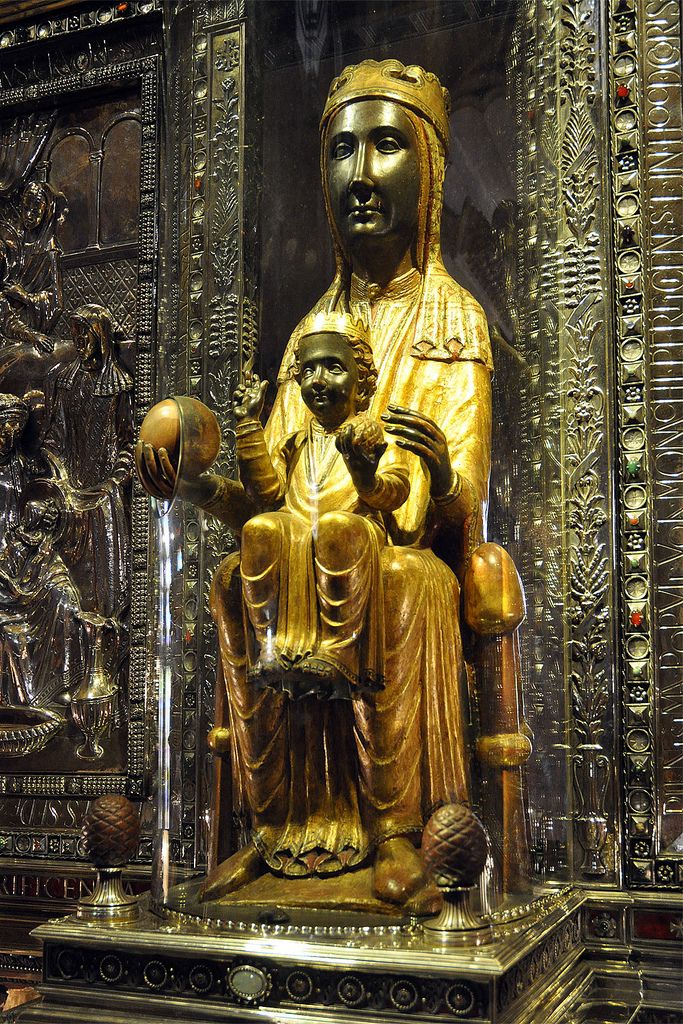
Convinced that the image of the Madonna of Montserrat was really unbearable, Gotmar, on reflection, decided that this was the Sign given to him by the Mother of God: they say, you don’t need to go anywhere, but, on the contrary, you need to
to build a temple right here, on this very spot.
And so they did. Soon, the chapel of St. Mary of Montserrat was built on that site, which, having undergone many changes over the centuries, turned into the current church , where the statue of the Black Madonna of Montserrat is kept.
And on the site of the grotto, where the image of the Virgin was discovered, they built a chapel, clinging, like a swallow’s nest, right to the rock. The grotto itself has also been preserved – it now houses
reduced copy of the original. The chapel is called: Santa Cova (Holy Cave).
From the Monastery of Montserrat to the Holy Cave there is a walking route with a length of about 1.5 km, which takes about half an hour one way – we will definitely talk about it with you
let’s talk.

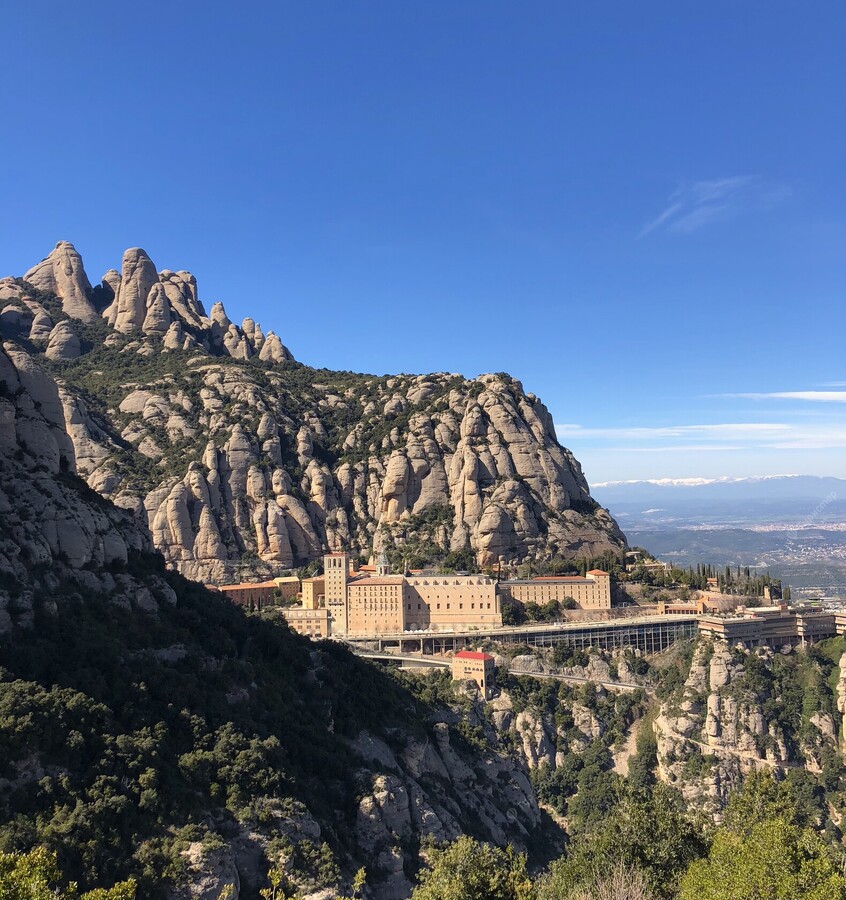 Then there’s the A2 that follows the Llobregat river. Upon reaching Abrera you can take the local road BV1201 to reach the monastery from the Monistrol side, or continue along the mountain to El Bruch, and take the B111.
Then there’s the A2 that follows the Llobregat river. Upon reaching Abrera you can take the local road BV1201 to reach the monastery from the Monistrol side, or continue along the mountain to El Bruch, and take the B111. But it can be an option to go back if you miss the last bus or train. By the Information Point of Montserrat you’ll find a list of taxi phone numbers that can come pick you up at the monastery and take you back to the city.
But it can be an option to go back if you miss the last bus or train. By the Information Point of Montserrat you’ll find a list of taxi phone numbers that can come pick you up at the monastery and take you back to the city.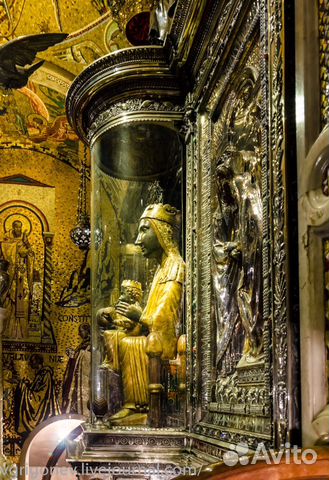
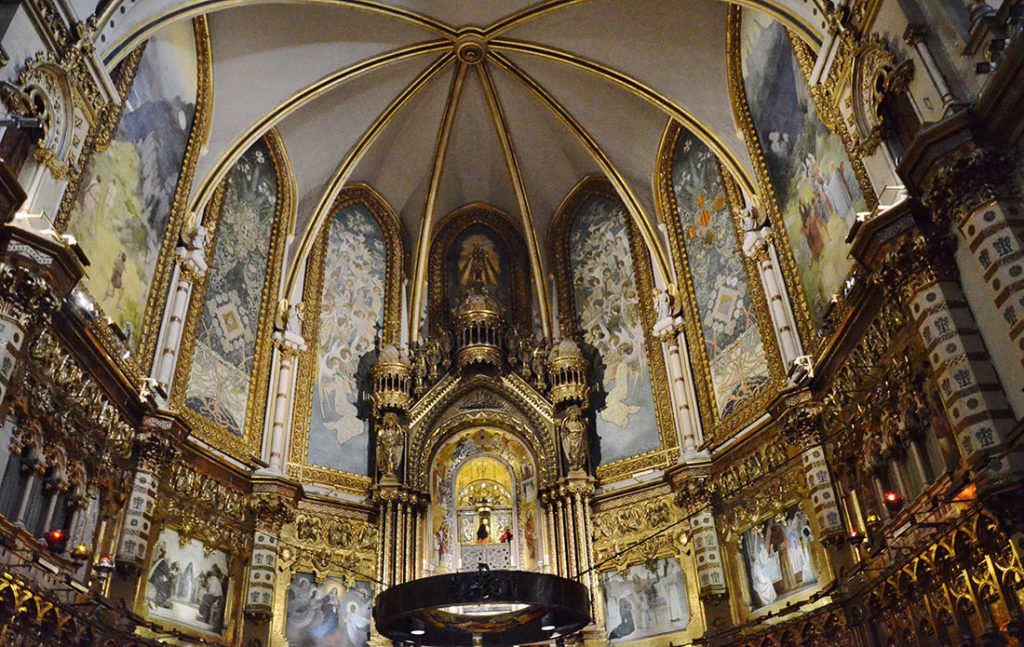 8 hours. Morning in Montserrat and lunch by the sea in the town of Sitges.
8 hours. Morning in Montserrat and lunch by the sea in the town of Sitges.